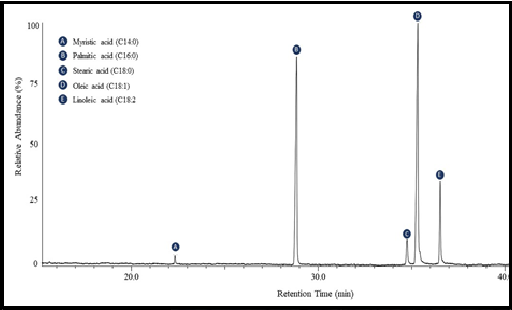Main Article Content
Abstract
Desulphurization of diesel fuel is necessary to be done to reduce sulphur content in the air. However, the desulphurization process will reduce the lubrication properties of diesel fuel. In order to overcome the problem, it needs bioadditive to improve the lubricity. Lubricity of diesel fuel can be improved by the subsistence of chemical compound that is hydroxyethyl esther (HEE). HEE is synthesized through the transesterification reaction of palm oil (triglycerides) and 1,2 ethanediol at 150 °C for 5 hours and K2CO3 catalyst as well. The conversion of TG into the products is 72.90%. The characterization using Gas Chromatography-Mass Spectrometry (GC-MS) indicates that the chemical compound in synthesis products comprise free fatty acids, hydroxyethyl esters and by-products. The obtained products can be used as bioadditives to improve the lubricity of diesel fuel.
Keywords
Article Details

This work is licensed under a Creative Commons Attribution-NonCommercial 4.0 International License.
References
- M. R. Subbarayan, J. S. Senthil Kumaar, and M. R. Anantha Padmanaban, “Experimental investigation of evaporation rate and exhaust emissions of diesel engine fuelled with cotton seed methyl ester and its blend with petro-diesel,” Transportation Research Part D: Transport and Environment, vol. 48, pp. 369–377, 2016, doi: 10.1016/j.trd.2016.08.024.
- A. Demirbas, H. Alidrisi, and M. A. Balubaid, “API gravity, sulfur content, and desulfurization of crude oil,” Petroleum Science and Technology, vol. 33, no. 1, pp. 93–101, 2015, doi: 10.1080/10916466.2014.950383.
- Z. Hu, L. Zhang, and Y. Li, “Investigation of tall oil fatty acid as antiwear agent to improve the lubricity of ultra-low sulfur diesels,” Tribology International, vol. 114, pp. 57–64, Oct. 2017, doi: 10.1016/j.triboint.2017.04.016.
- M. Craven et al., “Oxidative desulfurization of diesel fuel catalyzed by polyoxometalate immobilized on phosphazene-functionalized silica,” Applied Catalysis B: Environmental, vol. 231, no. March, pp. 82–91, 2018, doi: 10.1016/j.apcatb.2018.03.005.
- J. J. de Oliveira, A. C. M. de Farias, and S. M. Alves, “Evaluation of the biodiesel fuels lubricity using vibration signals and multiresolution analysis,” Tribology International, vol. 109, pp. 104–113, May 2017, doi: 10.1016/j.triboint.2016.12.031.
- I. M. A. Uchôa, A. A. D. Neto, E. Da Silva Santos, L. F. De Lima, and E. L. De Barros Neto, “Evaluation of lubricating properties of diesel based fuels micro emulsified with glycerin,” Materials Research, vol. 20, pp. 701–708, 2017, doi: 10.1590/1980-5373-mr-2016-0943.
- M. A. Hazrat, M. G. Rasul, and M. M. K. Khan, “Lubricity Improvement of the Ultra-low Sulfur Diesel Fuel with the Biodiesel,” Energy Procedia, vol. 75, pp. 111–117, 2015, doi: 10.1016/j.egypro.2015.07.619.
- Z. Hu, L. Zhang, and Y. Li, “Investigation of tall oil fatty acid as antiwear agent to improve the lubricity of ultra-low sulfur diesels,” Tribology International, vol. 114, no. April, pp. 57–64, 2017, doi: 10.1016/j.triboint.2017.04.016.
- L. Prasad, L. M. Das, and S. N. Naik, “Effect of castor oil, methyl and ethyl esters as lubricity enhancer for low lubricity diesel fuel (LLDF),” Energy and Fuels, vol. 26, no. 8, pp. 5307–5315, 2012, doi: 10.1021/ef300845v.
- A. C. Arifin, A. Aminudin, and R. M. Putra, “Diesel-Biodiesel Blend on Engine Performance: An Experimental Study,” Automotive Experiences, vol. 2, no. 3, pp. 91–96, 2019.
- S. R. Deshpande, A. K. Sunol, and G. Philippidis, “Status and prospects of supercritical alcohol transesterification for biodiesel production,” Wiley Interdisciplinary Reviews: Energy and Environment, vol. 6, no. 5, pp. 1–15, 2017, doi: 10.1002/wene.252.
- M. J. C. Rezende, C. R. Perruso, D. D. A. Azevedo, and A. C. Pinto, “Characterization of lubricity improver additive in diesel by gas chromatography-mass spectrometry,” Journal of Chromatography A, vol. 1063, no. 1–2, pp. 211–215, 2005, doi: 10.1016/j.chroma.2004.12.015.
- M. Lapuerta, J. Sánchez-Valdepeñas, D. Bolonio, and E. Sukjit, “Effect of fatty acid composition of methyl and ethyl esters on the lubricity at different humidities,” Fuel, vol. 184, pp. 202–210, 2016, doi: 10.1016/j.fuel.2016.07.019.
- T. Issariyakul and A. K. Dalai, “Biodiesel from vegetable oils,” Renewable and Sustainable Energy Reviews, vol. 31, pp. 446–471, 2014, doi: 10.1016/j.rser.2013.11.001.
- T. P. C. Souza et al., “Kinetic modeling of cottonseed oil transesterification with ethanol,” Reaction Kinetics, Mechanisms and Catalysis, vol. 128, no. 2, pp. 707–722, 2019, doi: 10.1007/s11144-019-01661-2.
- E. Sukjit, P. Poapongsakorn, K. D. Dearn, M. Lapuerta, and J. Sánchez-Valdepeñas, “Investigation of the lubrication properties and tribological mechanisms of oxygenated compounds,” Wear, vol. 376–377, pp. 836–842, Apr. 2017, doi: 10.1016/j.wear.2017.02.007.
- E. T. Rangel, A. C. Pinto, P. A. Z. Suarez, and M. J. C. Rezende, “Synthesis and Evaluation of Biocide and Cetane Number Improver Additives for Biodiesel from Chemical Changes in Triacylglycerides,” Journal of the Brazilian Chemical Society, vol. 29, no. 12, pp. 1–11, 2018.
- M. R. Shahbazi, B. Khoshandam, M. Nasiri, and M. Ghazvini, “Biodiesel production via alkali-catalyzed transesterification of Malaysian RBD palm oil - Characterization, kinetics model,” Journal of the Taiwan Institute of Chemical Engineers, vol. 43, no. 4, pp. 504–510, 2012, doi: 10.1016/j.jtice.2012.01.009.
- A. De and S. S. Boxi, “Application of Cu impregnated TiO2 as a heterogeneous nanocatalyst for the production of biodiesel from palm oil,” Fuel, vol. 265, no. October 2019, 2020, doi: 10.1016/j.fuel.2020.117019.
- E. Marlina, M. Basjir, M. Ichiyanagi, T. Suzuki, G. Jeremy, and W. Anggono, “The Role of Eucalyptus Oil in Crude Palm Oil As Biodiesel Fuel,” Automotive Experiences vol. 3, no. 1, pp. 33–38, 2020.
- A. Santoso, C. F. A. Hanindita, Sumari, and I. B. Rachman, “Synthesis of Biodiesel from Low-Quality Crude Palm Oil with Heterogeneous Catalyst Cao-ZnO,” IOP Conference Series: Materials Science and Engineering, vol. 515, no. 1, 2019, doi: 10.1088/1757-899X/515/1/012082.
- N. K. Attia, S. A. El-Mekkawi, O. A. Elardy, and E. A. Abdelkader, “Chemical and rheological assessment of produced biolubricants from different vegetable oils,” Fuel, vol. 271, p. 117578, 2020.

